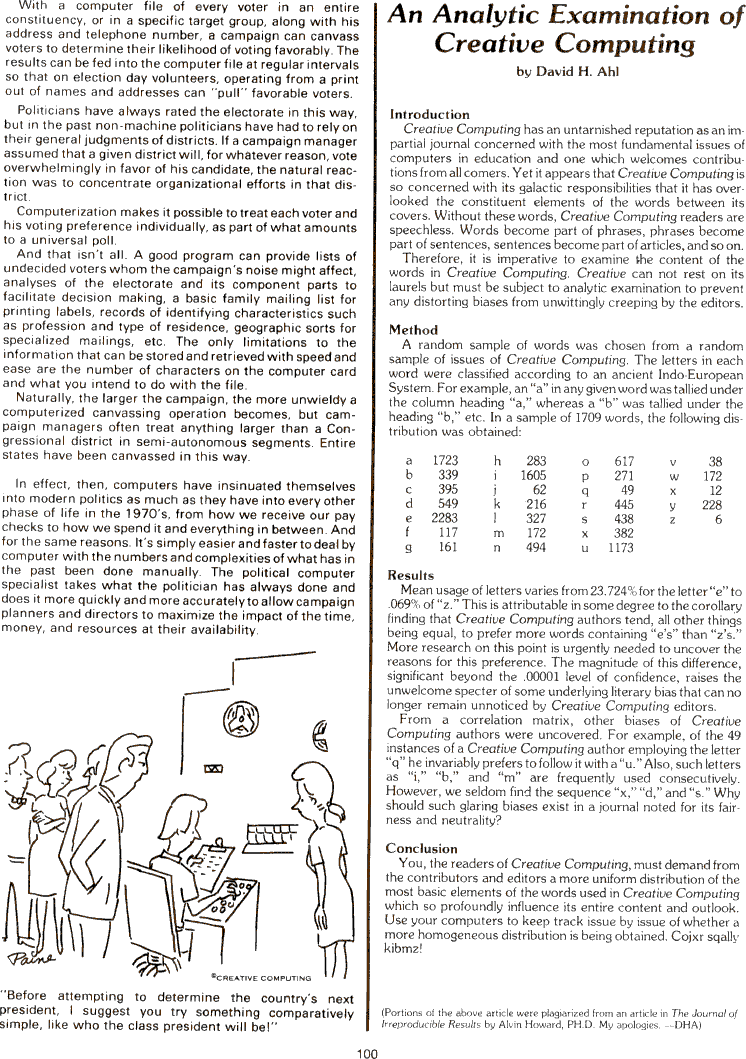by David H. Ahl

With a computer file of every voter in an entire constituency, or in a specific target group, along with his address and telephone number, a campaign can canvass voters to determine their likelihood of voting favorably. The results can be fed into the computer file at regular intervals so that on election day volunteers, operating from a print out of names and addresses can "pull" favorable voters. Politicians have always rated the electorate in this way, but in the past non-machine politicians have had to rely on their general judgments of districts. lf a campaign manager assumed that a given district will, for whatever reason, vote overwhelmingly in favor of his candidate, the natural reaction was to concentrate organizational efforts in that district. Computerization makes it possible totreat each voter and his voting preference individually, as part of what amounts to a universal poll. And that isn't all. A good program can provide lists of undecided voters whom the campaign's noise might affect, analyses of the electorate and its component parts to facilitate decision making, a basic family mailing list for printing labels, records of identifying characteristics such as profession and type of residence, geographic sorts for specialized mailings, etc. The only limitations to the information that can be stored and retrieved with speed and ease are the number of characters on the computer card and what you intend to do with the file. Naturally, the larger the campaign, the more unwieldy a computerized canvassing operation becomes, but campaign managers often treat anything larger than a Congressional district in semi-autonomous segments. Entire states have been canvassed in this way. In effect, then, computers have insinuated themselves into modern politics as much as they have into every other phase of life in the 197O's, from how we receive our pay checks to how we spend it and everything in between. And for the same reasons. lt's simply easier and faster to deal by computer with the numbers and complexities of what has in the past been done manually. The political computer specialist takes what the politician has always done and does it more quickly and more accurately to allow campaign planners and directors to maximize the impact of the time, money, and resources at their availability. [image]"Before attempting to determine the country's next president, I suggest you try something comparatively simple, like who the class president will be!" *** An Analytic Examination of Creative Computing by David H. Ahl Introduction Creative Computing has an untarnished reputation as an impartial journal concerned with the most fundamental issues of computers in education and one which welcomes contributions from all comers. Yet it appears that Creative Computing is so concerned with its galactic responsibilities that it has overlooked the constituent elements of the words between its covers. Without these words, Creative Computing readers are speechless. Words become part of phrases, phrases become part of sentences, sentences become part of articles, and so on. Therefore, it is imperative to examine the content of the words in Creative Computing. Creative can not rest on its laurels but must be subject to analytic examination to prevent any distorting biases from unwittingly creeping by the editors. Method A random sample of words was chosen from a random sample of issues of Creative Computing. The letters in each word were classified according to an ancient Indo-European System. For example, an "a" in any given word was tallied under the column heading "a," whereas a "b" was tallied under the heading "b," etc. ln a sample of 1709 words, the following distribution was obtained: a 1723 b 339 c 395 d 549 e 2283 f 117 g 161 h 283 i 1605 j 62 k 216 l 327 m 172 n 494 o 617 p 271 q 49 r 445 s 438 t 382 u 1173 v 38 w 172 x 12 y 228 z 6 Results Mean usage of letters varies from 23.724% for the letter "e" to .069% of "z." This is attributable in some degree to the corollary finding that Creative Computing authors tend, all other things being equal, to prefer more words containing "e's" than "z's." More research on this point is urgently needed to uncover the reasons for this preference. The magnitude of this difference, significant beyond the .00001 level of confidence, raises the unwelcome specter of some underlying literary bias that can no longer remain unnoticed by Creative Computing editors. From a correlation matrix, other biases of Creative Computing authors were uncovered. For example, of the 49 instances of a Creative Computing author employing the letter "q" he invariably prefers to follow it with a "u."Also, such letters as "i," "b," and "m" are frequently used consecutively. However, we seldom find the sequence "x,""d," and "s." Why should such glaring biases exist in a journal noted for its fairness and neutrality? Conclusion You, the readers of Creative Computing, must demand from the contributors and editors a more uniform distribution of the most basic elements of the words used in Creative Computing which so profoundly influence its entire content and outlook. Use your computers to keep track issue by issue of whether a more homogeneous distribution is being obtained. Cojxr sqally kibmz! (Portions of the above article were plagiarized from an article in The Journal of Irreproducible Results by Alvin Howard, PHD. My apologies. -DHA)

